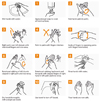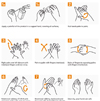2. Pittet D. Infection control and quality health care in the new millennium. Am J Infect Control. 2005; 33:258–267.
3. Pittet D, Sax H, Hugonnet S, Harbarth S. Cost implications of successful hand hygiene promotion. Infect Control Hosp Epidemiol. 2004; 25:264–266.

4. Shorter E. Ignaz Semmelweis: the etiology, concept, and prophylaxis of childbed fever. Med Hist. 1984; 28:334.

5. Price PB. Bacteriology of normal skin; a new quantitative test applied to the study of bacterial flora and disinfectant action of mechanical cleansing. J Infect Dis. 1938; 63:301–318.

6. Larson EL, McGinley KJ, Foglia AR, Talbot GH, Leyden JJ. Composition and antimicrobic resistance of skin flora in hospitalized and healthy adults. J Clin Microbiol. 1986; 23:604–608.

7. Noble WC. Dispersal of skin microorganisms. Br J Dermatol. 1975; 93:477–485.

8. Pittet D, Dharan S, Touveneau S, Sauvan V, Perneger TV. Bacterial contamination of the hands of hospital staff during routine patient care. Arch Intern Med. 1999; 159:821–826.

9. Ehrenkranz NJ, Alfonso BC. Failure of bland soap handwash to prevent hand transfer of patient bacteria to urethral catheters. Infect Control Hosp Epidemiol. 1991; 12:654–662.

10. Rotter M. Hand washing and hand disinfection. In : Mayhall CG, editor. Hospital epidemiology and infection control. 2nd ed. Philadelphia: Lippincott Williams & Wilkins;1999. p. 1339–1355.
11. Larson EL, Morton HE. Alcohols. In : Block SS, editor. Disinfection, sterilization, and preservation. 4th ed. Philadelphia: Lea & Febiger;1991. p. 191–203.
12. Price PB. Ethyl alcohol as a germicide. Arch Surg. 1939; 38:528–542.

13. Harrington C, Walker H. The germicidal action of alcohol. Boston Med Surg J. 1903; 148:548–552.

14. Coulthard C, Sykes G. The germicidal effect of alcohol with special reference to its action on bacterial spores. Pharmaceutical J. 1936; 137:79–81.
15. Pohle W, Stuart L. The germicidal action of cleaning agents: a study of a modification of price's procedure. J Infect Dis. 1940; 275–281.

16. Gardner AD. Rapid disinfection of clean unwashed skin; further experiments. Lancet. 1948; 2:760–763.

17. Sakuragi T, Yanagisawa K, Dan K. Bactericidal activity of skin disinfectants on methicillin-resistant Staphylococcus aureus. Anesth Analg. 1995; 81:555–558.

18. Kampf G, Jarosch R, Rüden H. Limited effectiveness of chlorhexidine based hand disinfectants against methicillin-resistant Staphylococcus aureus (MRSA). J Hosp Infect. 1998; 38:297–303.

19. Kampf G, Hofer M, Wendt C. Efficacy of hand disinfectants against vancomycin-resistant enterococci in vitro. J Hosp Infect. 1999; 42:143–150.

20. Platt J, Bucknall RA. The disinfection of respiratory syncytial virus by isopropanol and a chlorhexidine-detergent handwash. J Hosp Infect. 1985; 6:89–94.

21. Krilov LR, Harkness SH. Inactivation of respiratory syncytial virus by detergents and disinfectants. Pediatr Infect Dis J. 1993; 12:582–584.

22. Boyce JM, Pittet D. Healthcare Infection Control Practices Advisory Committee. HICPAC/SHEA/APIC/IDSA Hand Hygiene Task Force. Guideline for hand hygiene in healthcare settings recommendations of the Healthcare Infection Control Practices Advisory Committee and the HIPAC/SHEA/APIC/IDSA Hand Hygiene Task Force. Am J Infect Control. 2002; 30:S1–S46.
23. Larson EL. APIC guideline for handwashing and hand antisepsis in health care settings. Am J Infect Control. 1995; 23:251–269.

24. Denton GW. Chlorhexidine. In : Block SS, editor. Disinfection, sterilization, and preservation. 4th ed. Philadelphia: Lea & Febiger;1991. p. 274–289.
25. Aly R, Maibach HI. Comparative study on the antimicrobial effect of 0.5% chlorhexidine gluconate and 70% isopropyl alcohol on the normal flora of hands. Appl Environ Microbiol. 1979; 37:610–613.

26. Lowbury EJ, Lilly HA, Ayliffe GA. Preoperative disinfection of surgeons' hands: use of alcoholic solutions and effects of gloves on skin flora. Br Med J. 1974; 4:369–372.

27. Gottardi W. Iodine and iodine compounds. In : Block SS, editor. Disinfection, sterilization, and preservation. 4th ed. Philadelphia: Lea & Febiger;1991. p. 152–166.
28. Goldenheim PD. In vitro efficacy of povidone-iodine solution and cream against methicillin-resistant Staphylococcus aureus. Postgrad Med J. 1993; 69:Suppl 3. S62–S65.
29. Traore O, Fayard SF, Laveran H. An in-vitro evaluation of the activity of povidone-iodine against nosocomial bacterial strains. J Hosp Infect. 1996; 34:217–222.

30. McLure AR, Gordon J. In-vitro evaluation of povidone-iodine and chlorhexidine against methicillin-resistant Staphylococcus aureus. J Hosp Infect. 1992; 21:291–299.

31. Kim HB. National hand hygiene campaign in Korea-progress and challenges. J Microbiol Immunol Infect. 2015; 48:S11.

32. Pittet D, Mourouga P, Perneger TV. Compliance with handwashing in a teaching hospital: infection control program. Ann Intern Med. 1999; 130:126–130.
33. Korea Centers for Disease Control and Prevention. Guidelines for prevention and control of Healthcare associated infections. Cheongju: Korea Centers for Disease Control and Prevention;2017.
34. Ellingson K, Haas JP, Aiello AE, Kusek L, Maragakis LL, Olmsted RN, Perencevich E, Polgreen PM, Schweizer ML, Trexler P, VanAmringe M, Yokoe DS. Society for Healthcare Epidemiology of America (SHEA). Strategies to prevent healthcare-associated infections through hand hygiene. Infect Control Hosp Epidemiol. 2014; 35:937–960.

35. Umscheid CA, Agarwal RK, Brennan PJ. Healthcare Infection Control Practices Advisory Committee. Updating the guideline development methodology of the Healthcare Infection Control Practices Advisory Committee (HICPAC). Am J Infect Control. 2010; 38:264–273.

36. Sax H, Allegranzi B, Uckay I, Larson E, Boyce J, Pittet D. ‘My five moments for hand hygiene’: a user-centred design approach to understand, train, monitor and report hand hygiene. J Hosp Infect. 2007; 67:9–21.

37. Pittet D, Hugonnet S, Harbarth S, Mourouga P, Sauvan V, Touveneau S, Perneger TV. Effectiveness of a hospital-wide programme to improve compliance with hand hygiene: Infection Control Programme. Lancet. 2000; 356:1307–1312.

38. Chun JY, Seo HK, Kim MK, Shin MJ, Kim SY, Kim M, Kim CJ, Song KH, Kim ES, Lee H, Kim HB. Impact of a hand hygiene campaign in a tertiary hospital in South Korea on the rate of hospital-onset methicillin-resistant Staphylococcus aureus bacteremia and economic evaluation of the campaign. Am J Infect Control. 2016; 44:1486–1491.









 PDF
PDF ePub
ePub Citation
Citation Print
Print



 XML Download
XML Download